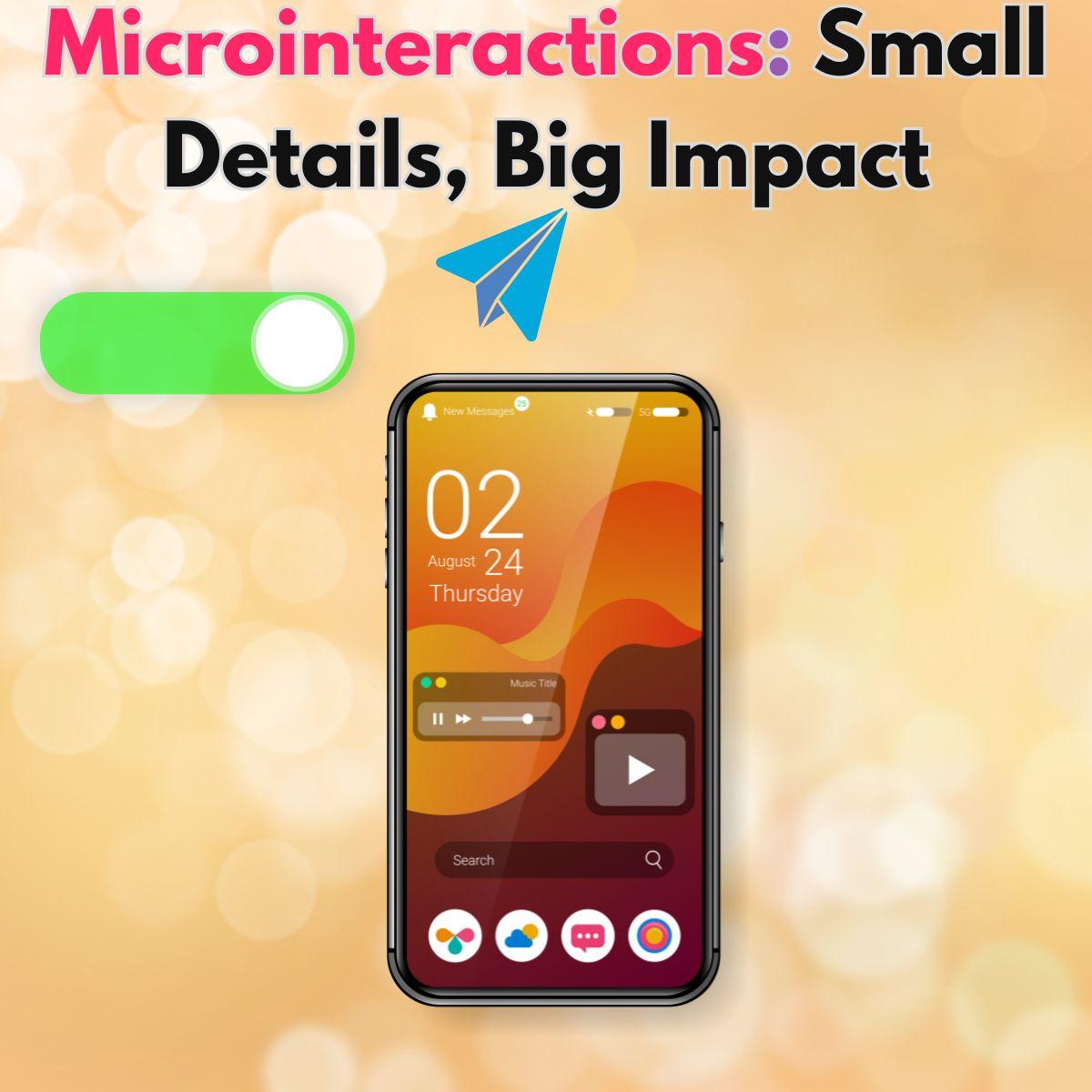Posted At: Aug 14, 2025 - 368 Views

✨ Microinteractions: Small Details, Big Impact on User Experience
When it comes to crafting a truly delightful user experience, the devil is in the details. One of the most underrated but incredibly powerful elements of UX design is the microinteraction—those tiny, often invisible moments that provide feedback, improve usability, and add a touch of personality to digital products.
Whether it's a subtle animation when you "like" a post or a gentle vibration on a button press, microinteractions are the difference between a good experience and a great one.
In this blog, we’ll explore what microinteractions are, why they matter, and how to design them effectively.
🔍 What Are Microinteractions?
Microinteractionsare small, contained product moments that perform a single task. They often go unnoticed, but they play a vital role in enhancing the user’s experience.
Examples:
- A heart icon that pulses when tapped
- A swipe animation to delete an email
- A loading spinner with a custom animation
- A sound that plays when toggling a setting
- Typing indicators in messaging apps
These subtle touches create a more intuitive and engaging experience—users might not consciouslynotice them, but they'd definitelymiss them if they were gone.
🎯 Why Microinteractions Matter
1. Feedback & Communication
They tell users their action was registered—whether it's saving a setting, sending a message, or completing a task.
2. Improve Usability
They guide users and make interfaces more intuitive. Think of toggles changing color or slight haptic feedback confirming a press.
3. Build Emotional Connection
A playful animation or thoughtful detail can make an app feel friendlier, more human, and even joyful.
4. Brand Differentiation
Unique microinteractions help define a product's personality. Think of the satisfying “pop” on Instagram likes or the playful Slack loading screens.
🔄 Anatomy of a Microinteraction
According to designer Dan Saffer, a microinteraction has four parts:
- Trigger– What initiates the interaction (e.g., tap, swipe, scroll).
- Rules– What happens in response to the trigger.
- Feedback– Visual, auditory, or tactile responses.
- Loops & Modes– How it evolves over time or changes state.
Understanding these parts helps ensure your microinteractions are intentional and functional—not just eye candy.
💡 Where to Use Microinteractions
✅ Buttons & Toggles
- Add animation or sound when toggling settings
- Use motion to indicate success or failure
📩 Forms & Inputs
- Show progress, errors, or confirmations in real-time
- Use inline validation animations
🔄 Loading & Transitions
- Replace boring spinners with branded animations
- Offer context during wait times (e.g., “Almost there!”)
🧭 Navigation & Feedback
- Highlight active tabs with motion
- Animate scroll or page transitions smoothly
🎉 User Engagement
- Celebrate milestones (e.g., completing a goal)
- Use delightful feedback for user-generated content
🧠 Best Practices for Designing Microinteractions
1. Keep It Purposeful
Every microinteraction should serve a functional or emotional goal—avoid unnecessary animations that slow things down.
2. Don’t Overdo It
Too many animations can feel gimmicky or annoying. Be subtle, consistent, and elegant.
3. Match the Brand Voice
Your microinteractions should align with your product's personality—professional, playful, bold, or minimalist.
4. Make It Fast
Microinteractions should feel instant. Anything slower than 400ms starts to feel sluggish.
5. Design for All Users
Make sure animations are accessible. Offer motion-reduced versions and consider users with cognitive or visual impairments.
6. Test with Real Users
Observe how users react—do they smile? Do they get confused? Microinteractions are meant to clarify and delight.
🔧 Tools & Frameworks
Designers and developers can leverage a variety of tools to craft great microinteractions:
Role | Tools |
🎨 Design | Figma, Adobe XD, Principle, Lottie |
💻 Web Dev | CSS Animations, Framer Motion, GSAP, React Spring |
📱 Mobile Dev | SwiftUI, Jetpack Compose, Flutter, Lottie |
Using vector-based animations like Lottieallows for lightweight, high-performance motion in both web and mobile environments.
🧩 Real-World Examples
- Pulsing heart animation on likes
- Stories swipe interaction
✅ Slack
- Custom emoji animations
- Loading screen easter eggs
✅ Duolingo
- Animated mascots for encouragement
- Fun, bouncy transitions between lessons
These products use microinteractions not just to inform, but to entertain and engage.
🚀 Final Thoughts
Microinteractions may be small, but their impact is huge. When designed thoughtfully, they create a polished, delightful experience that makes users feel confident, connected, and cared for.
Whether you’re building a startup MVP or fine-tuning a mature product, investing in microinteractions is investing in user joy.
🔁 TL;DR
- Microinteractions are small UI responses to user actions.
- They provide feedback, enhance usability, and add emotional value.
- Best when subtle, purposeful, and on-brand.
- Designed well, they boost UX without users even realizing it.
Ready to level up your product’s experience? Start small—with microinteractions—and watch your UX come alive.
